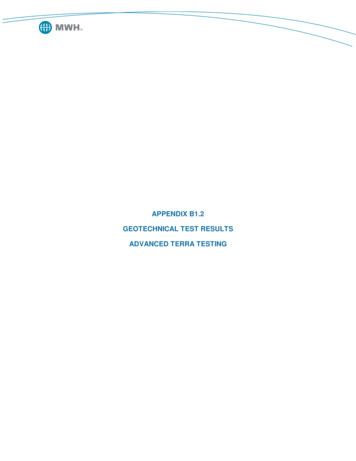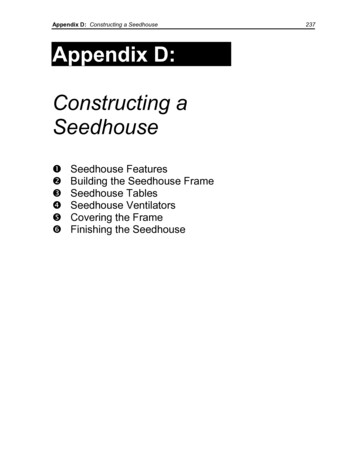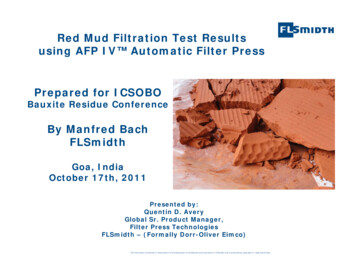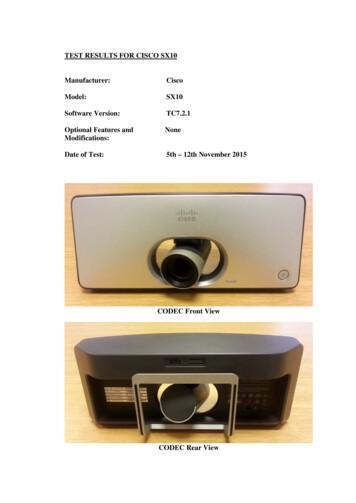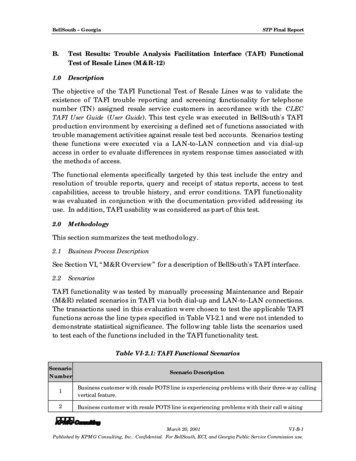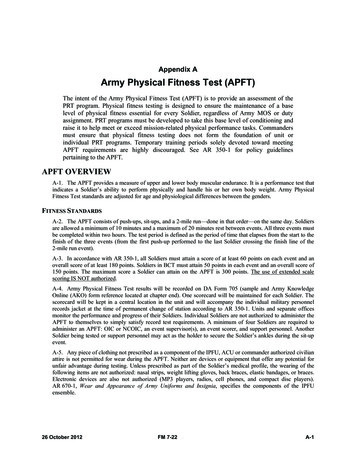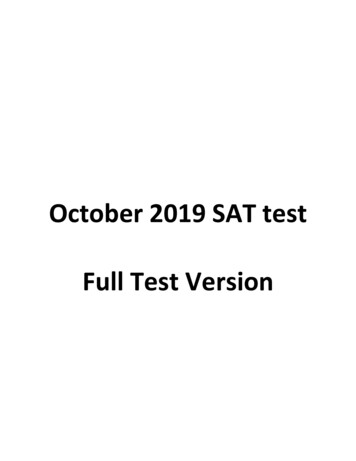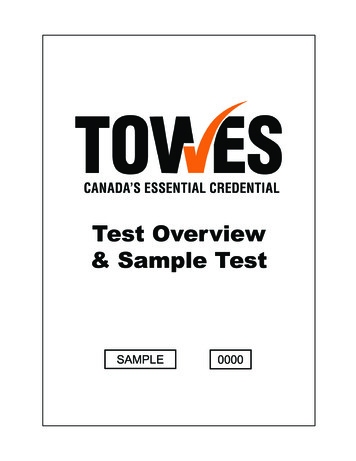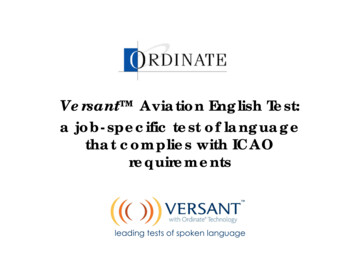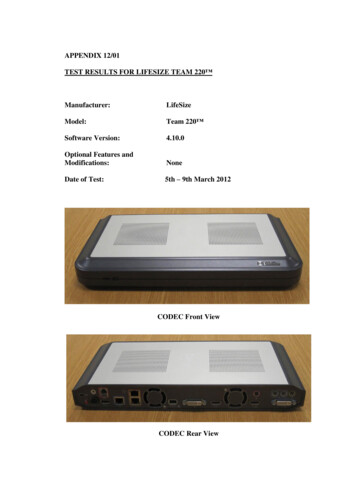
Transcription
APPENDIX 12/01TEST RESULTS FOR LIFESIZE TEAM 220 Manufacturer:LifeSizeModel:Team 220 Software Version:4.10.0Optional Features andModifications:NoneDate of Test:5th – 9th March 2012CODEC Front ViewCODEC Rear View
Team 220 10x HD CameraCODEC with Vertical StandLifeSize Phone Desk Microphone /Conference PhoneRemote Controlii
CO N T E N T SPage No.A: EXECUTIVE SUMMARYB:SETUP PROCEDURE.1.3C: HARDWARE DESCRIPTION .3D: SYSTEM OPERATION.10E:VIDEO TESTS.15F:AUDIO TESTS.16G: DATA TESTS.16H: CONNECTIVITY.16Appendix 1 Detailed Physical Information .18Appendix 2 Detailed Video Tests .20Appendix 3 Detailed Audio Tests .26iii
A:EXECUTIVE SUMMARYThe IP capable high definition Lifesize Team 220 conferencing system isdesigned to be installed either in a small to medium sized conference room or aspart of a Rollabout system.The system includes a high definition (HD) Camera, microphone/s and infraredremote control. A four site continuous presence on-board Multipoint ConferenceUnit (MCU) is included as standard.The system is available with 2 camera and 2 microphone options:CODEC, Camera 200, Dual MicPodsCODEC, Camera 10x, Dual MicPodsCODEC, Camera 200, LifeSize Phone CODEC, Camera 10x, LifeSize Phone The 10x Camera has a 10x zoom lens and is more sensitive in low light conditionsthan the 200 with its 4x zoom.The systems supplied for evaluation included the 10x Cameras and the LifeSizePhone desk microphone/conference phones.The system is capable of conferencing up to a maximum picture resolution of1920x1080 pixels (1080p) at 30fps or 1280x720 pixels (720p) at 60fps at amaximum connection speed of 6 Mbit/s. Compatibility with other H.323 CODECSis achieved across a range of resolutions from CIF (352x288) to 1920x1080 pixels,the quality of the conference being dependent upon the capability of the remoteCODEC and the speed of connection.The default setting of 720p @ 60 frames per second was used for the majority of theevaluation.Pros:The sensitivity of the Camera 10x is improved over earlierLifeSize modelsDual monitor as standardOn-board 4 site continuous presence MCU as standardGood compatibility with other CODECSMay be used in permanent installations or as a RollaboutCons:Camera mechanical noiseCooling fan noiseRestricted frame rate on Presentation channel1
Feature Summary:Video standardsSupported videoresolutionsCommunicationsAudio standardsCameraVideo inputsVideo outputsAudio inputsAudio outputsVC AuxiliaryfeaturesH.261, H.263, H.263 and H.264QSIF (176x120)QCIF (176x144)SIF (352x240)CIF (352x288)4SIF (704x480)4CIF (704x576)720p (1280x720) at 60 fps1080p (1920x1080) at 30fpsH.323 128Kbps - 6MbpsH.320 via optional LifeSize NetworkerG.711, G.722, G.722.1, G.728, G.729, Siren 14 andMPEG4 AAC-LC 16KHz audio coding4x or 10x Optical zoom camera, PTZ function, 1080pnative resolution, 10 camera presents, far end cameracontrol, second 720p only camera may be addedPTZ Camera input (1080p), second camera input (720p),VGA/DVI InputDual monitor supportVGA/DVI video output, HDMI outputLifesize Phone , MicPod microphone, 2 x stereo line in,analogue telephone line.HDMI audio output, 3.5mm mini jack audio outputH.239 second video channel up to 720p resolution inpoint to point and Multisite calls. Only the VGA inputmay be shared on the H.239 channel.Four site internal H.323 MCU supporting ContinuousPresence only.EncryptionLifesize Phone desk microphone/speakerphoneAES Encryption2
B:SETUP PROCEDUREThe camera (positioned adjacent to a picture monitor) and the CODEC have theirown power supplies and together with the LifeSize Phone and infra red remotecomplete the package. Cabling the system was easy and involved:Connecting the supplied HDMI-HDMI and DVI-DVI leads between theCODEC and the high definition monitors.Connecting the HDMI cable between the CODEC and the camera.Cabling the Lifesize Phone to the CODEC.Establishing an Ethernet IP network connection through the single RJ45RJ45 cable.Connecting power to the CODEC and camera from their external powersupplies.System set up was conveniently configured through the “on-screen” menus via theremote control. IP address, IP Gateway, Subnet mask and Gatekeeper (optional)address were all entered through these menus.Approximate set-up time:20 MinutesDocumentation quality:The documentation was concise and easy to followand included: A printed Quick Reference card, withuser manual and software release notes on CD.The entire set up procedure was straightforward.C:HARDWARE DESCRIPTIONGeneralThe compact 1U deep CODEC may be cabinet mounted horizontally under apicture monitor or vertically on the supplied stand, it cannot be rack mounted. Thebasic system is an IP only unit with a single 10/100 Mbit/s, auto switching, Ethernetconnection, enabling single site connection speeds of up to 6 Mbit/s, or multi-site(MCU) connections with a total site bandwidth of 6 Mbit/s. The Ethernet port maybe manually configured or set to auto negotiate.An optional LifeSize Networker IP/ISDN gateway will provide H.320 ISDNconnectivity if required. This option was not tested during the evaluation.The CODEC supports over 200 video resolutions including:The basic CIF format resolution of 352x288 pixelswCIF at 400x244w288p at 512x288w432p at 768x432w480p at 848x480High definition (HD) w720p i.e. 1280x7203
High definition (HD) w1080p i.e.1920x1080The following display resolutions and maximum frame rates are supported:1280 x 720p1280 x 768p1920 x 1080p1920 x 1080i60fps60fps30fps60fpsMonitors used during the tests did not support 1080p, 30 frames /second, so all1080 images were viewed at a display resolution of 1080i, 60fps.The maximum transmitted resolution and frame rate are determined by the displayresolution selection and the camera video setting. The default settings are 720p andmotion.CODEC Display Resolution set to 720pCamera VideoMotionModeConnectionResolutionFrame rateBandwidth128 Kbit/s432 x 24030384 Kbit/s736 x 41660768 Kbit/s1024 x 576601 Mbit/s1232x 688602 Mbit/s1280x720603 Mbit/s1280x720604 Mbit/s1280x720606 Mbit/s1280x72060CODEC Display Resolution set to 1080iCamera VideoMotionModeConnectionResolutionFrame rateBandwidth128 Kbit/s432 x 24030384 Kbit/s912 x 51230768 Kbit/s1280 x 720301 Mbit/s1480 x 832302 Mbit/s1920 x 1080303 Mbit/s1920 x 1080304 Mbit/s1920 x 1080306 Mbit/s1920 x 108030SharpnessResolutionFrame rate1280 x 7201280 x 7201280 x 7201280 x 7201280 x 7201280 x 7201920 x 10801920 x 1080315303060603030SharpnessResolution1280 x 7201920 x 10801920 x 10801920 x 10801920 x 10801920 x 10801920 x 10801920 x 1080Frame rate15101530303030Single and dual picture monitors are supported together with HDMI and DVI-I highdefinition outputs.The HDMI connection includes the main audio output signal but additionalanalogue audio outputs are also provided.4
The main video output includes on-screen menus and the soft key iconscorresponding to the four colour-coded buttons on the remote control.Main MenuBoth Picture in Picture (PIP) and Picture outside Picture (POP) display formats areoffered which allows both near and far end images to be displayed simultaneouslyon a single picture monitor.Far Image Full Screen, Near Image Picture in Picture (PIP) with MenuOverlay5
Side by Side Far and Near Images, Picture outside Picture (POP)In single monitor mode the “layout-button” on the remote control cycles betweena number of screen display layouts. Picture in Picture (PIP) may be set to be On,Off or Auto; in Auto when a change in the picture is detected the PIP and on-screenmenu are displayed for a user definable time and then both fade out - default fadetime is 10 seconds.With the main camera only being transmitted there are 3 screen display layoutoptions:Full screen far end image PIP of near end imageFull screen near end image PIP of far end imageSide by side near and far end imagesWhen an H.329 presentation image together with the main camera image are eithertransmitted or received seven screen display layout options are available:Large presentation image plus small near and far end images POPLarge far end image plus small presentation and near end images POPLarge near end image plus small presentation and far end images POPPresentation image full screen plus near and far end images as PIPsFar end image full screen plus presentation and near end images as PIPsNear end image full screen plus presentation and far end images as PIPsPresentation and far end images side by side POP and near end image as aPIP6
Large Presentation Image, Small Far and Near Images POPSide by Side Presentation and Far Images, Near Image PIPIn dual monitor mode if the second monitor has its display set to“Calls Presentations”, the monitors display the following images:Not in a callIn a call with nopresentationmaterialMain MonitorNear image menuFar image menu7Second MonitorSource connected to theDVI-I inputNear Image
In a call withFar image Near image Presentation materialpresentationside by sidematerial transmittedor receivedThe LifeSize 10x HD camera features pan, tilt and zoom functions with a widehorizontal viewing angle of 70 degrees and connects to the CODEC through thestandard 3 metre HDMI cable. As an option this cable may be extended up to amaximum of 10 metres. Ten camera pre-set positions may be recalled from theremote control.The camera menu includes a range of manual settings for exposure, white balanceand anti-flicker. A second camera may be connected via the CODEC‟s fire-wire„type‟ input connector. Only 720p cameras are supported and these also requiretheir own external power supply.The 10x camera is more sensitive than earlier LifeSize 1080p examples andproduces good results at lower lighting levels. The operation of the camera Pan andZoom controls however does generate a significant level of mechanical noise, theCODECs cooling fan also generates some noise. The auto focus was slow torespond on occasions particularly at wide zoom angles and either locked in or out offocus, a slight adjustment was then required to the pan, tilt or zoom functions toreinitiate auto focus and thus correct the errors.The CODEC supports both remote camera control and remote video sourceselection.A PC may be interfaced directly via the DVI-I/VGA connector on the rear of theCODEC. Although no supported resolutions or frame rates are specified, weobserved successful connections at the following resolutions:VGA800 x 6001024 x 7681280 x 7201280 x 7681280 x 8001280 x 1024DVI-I800 x 6001024 x 7681280 x 7201280 x 7681280 x 8001280 x 10241360 x 7681680 x 10501920 x 1080During an H.323 call a second unidirectional video channel (dual stream) isprovided through the H.239 protocol. Thus video from the camera and a PC couldbe transmitted simultaneously. The bandwidth split between main and H.239channels may be defined by the user.The MultiSite (MCU) offers up to four-site H.323 MCU conferences, the host8
Lifesize Team 220 system plus three other remote sites. The speed of each siteconnection is dependent upon the number of sites in the MCU conference and theoverall connection bandwidth. Audio bridging (for telephone calls) is also providedinto conferences by connecting a standard telephone line to the CODEC.Several audio formats are supported by the LifeSize system, including the ITUstandard MPEG-4 AAC-LC, giving 16KHz analogue audio.The MicPod microphone includes a microphone mute button. In larger locationstwo MicPods may be connected by using a splitter cable. Alternatively the LifeSizePhone provides the conference microphone together with a fully featuredconference telephone. A standard telephone line may be connected to the CODECor it will operate as an SIP* phone. To provide basic system control, this phoneincludes a dial pad, volume control and a microphone mute button.*SIP-Session Initiation Protocol. An international standard for phoning over IPnetworks, SIP also transports video and instant messaging if requiredLifeSize Phone The LifeSize Phone incorporates 16 microphones in a circular microphone arraywith beam forming for high directivity. The unit can also radiate far end soundthrough its internal loudspeaker but the speakers on the picture monitor or anexternal audio system may be preferred for this task.Mini jack connectors allow for straightforward integration with standard PC audiovia the auxiliary line inputs.A Kensington lock is provided on the rear of the CODEC for added security.9
D: SYSTEM OPERATIONThe system may be controlled either locally from the remote control or fromanother location over the network. The system does not include an RS232 port forintegration with a room control system. Calls may also be initiated and terminatedfrom the LifeSize Phone desktop unit.The remote control includes four context sensitive colour coded buttons: triangle,square, circle and return, the function of each button is indicated by the on-screenmenu bar. This indication is vital as the function of each button can changedepending on how the system is used.On Screen Menu Bar indicating the Function of the Colour Coded ButtonsLifeSize Remote Control10
There are dedicated buttons for Call, Hang up, Microphone mute, Near/Far camera,Display layout, Volume, Zoom and Input select. Selecting Microphone mute cutssound both from the microphone and the auxiliary audio input. The camera has 10pre-set positions which are stored and recalled via the remote control.The system takes two minutes forty seconds to boot up from cold. When not in acall the system automatically reverts to screensaver mode after a user-definableperiod of 1, 10, 20, 30 minutes or never. Sleep mode may also be activated after 1,10, 20 or 30 minutes, 1, 2, 3 or 4 hours of inactivity. An incoming call or pressing aremote control button will then return the system to active mode.The Statistics menu displays call status data including resolution, connection speed,compression protocols, packet loss and frame rate for the main video channel.Frame rate information is not available for the second H.239 channel.In wide screen mode, a 4 x 3 aspect ratio video image transmitted from a computeris displayed on a widescreen monitor with the familiar black bars on each side ofthe image. To minimise this effect the CODEC has a “Video Stretch” facility thatstretches the image horizontally to fill the available wide screen display resulting inlateral distortion of the image.An H.239 connection is initiated by selecting “Presentation Start” through theremote control and the on-screen graphical interface. The main camera normallyoccupies one channel and another selected image source the second channel. Theremote site then receives separate images for display on two monitors.During tests between Lifesize Team 220 systems the second H.239 channelachieved a maximum resolution of 1280 x 720 pixels at around 15 frames persecond (the system statistics do not report H.239 frame rate). The connection speedhad to exceed 2 Mbit/s with bandwidth allocation set to 50:50 (camera: presentationmaterial) to maximise the frame rate. Increasing the overall bandwidth to 4 or6Mbit/s did not increase this frame rate above the estimated 15fps it did howeverimprove the overall quality by reducing image artefacts. Where frame rate is criticalon presentation material consideration should be given to transmitting it on themain channel which will deliver 30 fps.Controlling an MCU conference is a simple procedure:1. Select the “Call” button during a conference2. Enter the number of the additional site into the call menu or select the site fromthe directory or the recent call list.3. The additional site will then be connected to the conference.Individual calls or all connections may be disconnected using the graphic interface.11
The MCU operates in continuous presence mode only and at the Team 220 providesa number of screen layouts in Single monitor mode:Traditional quad split of the four sitesFull screen of any site and PIP images of the other threeLarge image of the first remote site to connect and POP images of the otherthree.Four Sites Quad SplitFull Screen Site with Multiple PIPs12
Large Image of the First Connected SiteWhen presentation material is displayed additional layouts are availablePresentation Large with Four Sites video POP images13
Presentation with Remote Sites Quad Split, Local Site PIPRemote configuration and control is available via a web browser, with passwordprotection, a useful tool for configuring the system and remote monitoring of calls.Call status, diagnostic information, and web snapshots of input and output imagestogether with the ability to initiate and terminate calls are available through the webinterface. A fully functional web version of the remote control is also available.Remote Configuration Screen ShotScreenshot reproduced by permission of LifeSize14
Remote Web Snapshots with StatisticsScreenshot reproduced by permission of LifeSizeE:VIDEO TESTS SUMMARYThe overall video quality of conference images was good but we preferred theappearance of the default 720p 60 fps images to the higher resolution ones at 1080p30 fps. The quality of standard videoconference type material at 2Mbit/s and abovewas also good but fast moving movie trailer material transmitted on the mainchannel even at 6Mbit/s did appear slightly jerky.The auto focus was slow to respond on occasions particularly at wide zoom anglesand either locked in or out of focus, a slight adjustment was then required to thepan, tilt or zoom functions to reinitiate auto focus and thus correct the errors.The restriction of presentation channel frame rate to 15 frames per second even atthe highest connection bandwidth may require that motion sensitive presentationvideo has to be transmitted on the main channel.15
F:AUDIO TESTS SUMMARYSetupThe echo canceller is fully automatic in operation. The quality of echocancellation and doubletalk was very good.Audio levels adequate? (Yes/No)Audio quality acceptable? (Yes/No)Echo cancellation acceptable?(Yes/No)Quality of double talkG:Lecture TheatreNot testedNot testedNot testedRoomYYYNot testedVery GoodDATA TESTSA PC may be directly connected to the CODEC via the DVI-I/ VGA interface.H:CONNECTIVITYConnectivity between Like MachinesH.323There were no problems connecting between the LifeSize Team 220 units.During an H.323 call the network connection was removed and reconnected after aspecific time.5 Seconds15 Seconds20 Secondssecondss30 SecondsPicture froze - successful reconnection, call does not terminatePicture froze - successful reconnection, call does not terminatePicture froze - successful reconnection, call then terminates after 3-4secondsPicture froze - successful reconnection, call then terminates after 3-4secondsTime to ConnectH.32310 SecondsConnectivity with Other Machines (models listed with comments)H.323Successful connections were made in each direction with the following CODECs atthe maximum bandwidth possible, where the system supported H.239 presentationmaterial was also shared.16
CODECModel and SoftwareVersionPolycom VSX7000S/W 9.0.5.1Tandberg Edge 95*S/W F9.0 PALTandberg 6000 MXP*S/W F9.0 PALTandberg C40S/W TC4.2.1Tandberg C60S/W TC4.2.1Tandberg C90S/W TC4.2.1Polycom HDX 9002S/W 2.6.0Lifesize Room 200S/W 4.7.10Lifesize TeamS/W 4.7.19CallBandwidth2 Mbit/sResolutionTransmitted bythe Team 220352 x 288ResolutionReceived bythe Team 220352 x 2882 Mbit/s352 x
TEST RESULTS FOR LIFESIZE TEAM 220 . CODEC, Camera 200, LifeSize Phone CODEC, Camera 10x, LifeSize Phone The 10x Camera has a 10x zoom lens and is more sensiti
